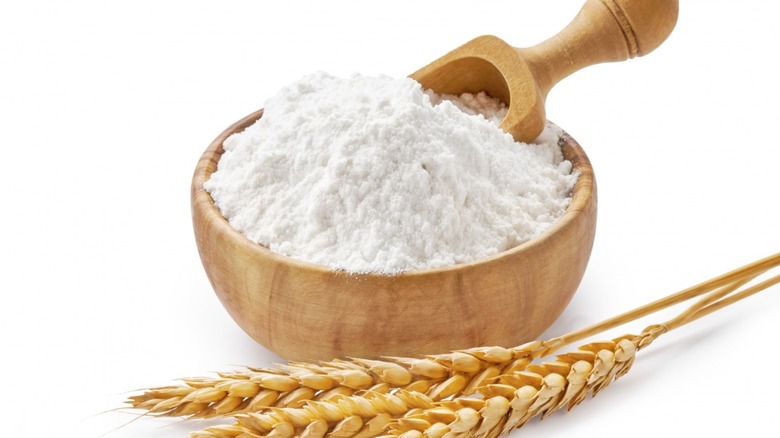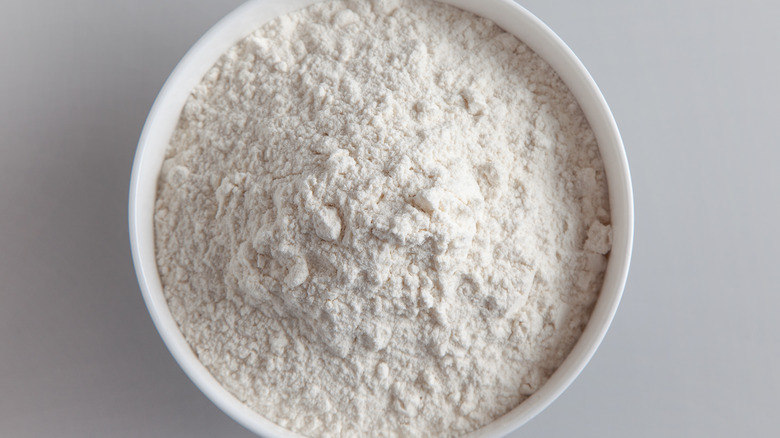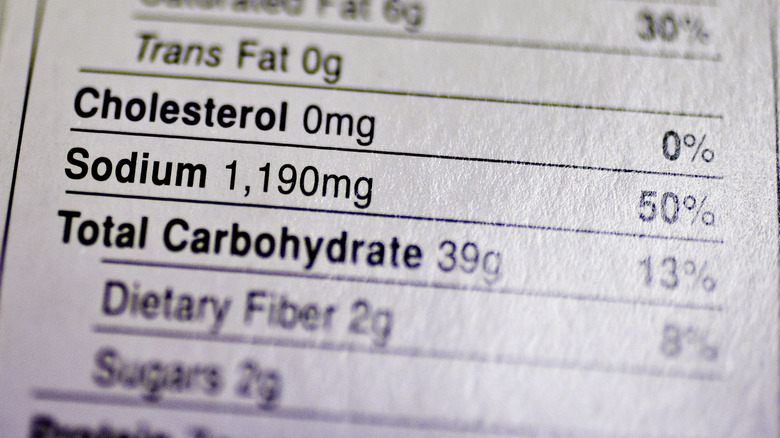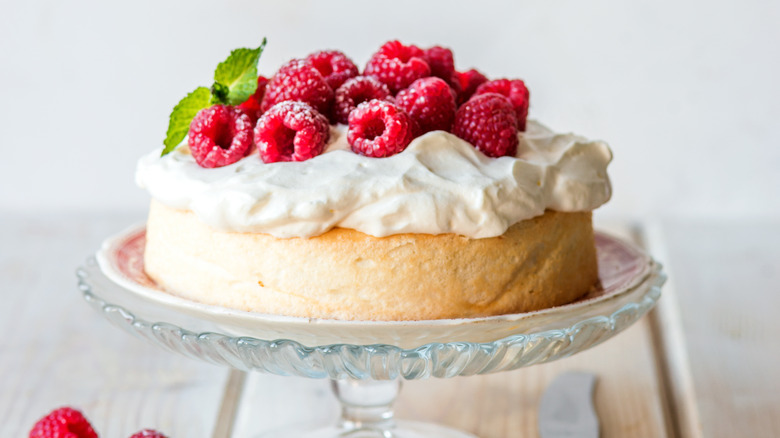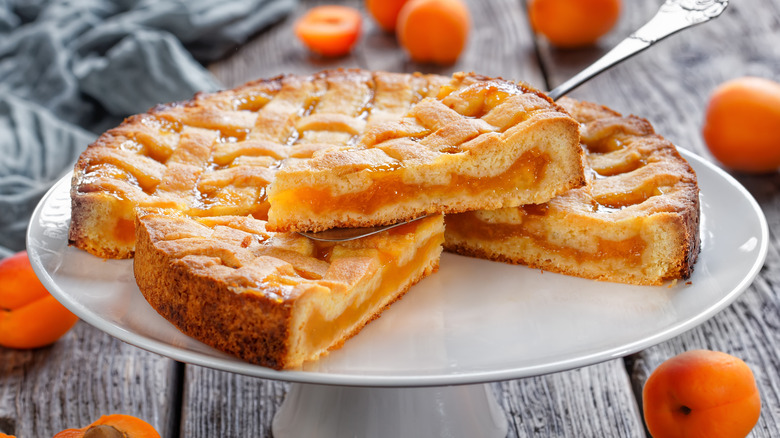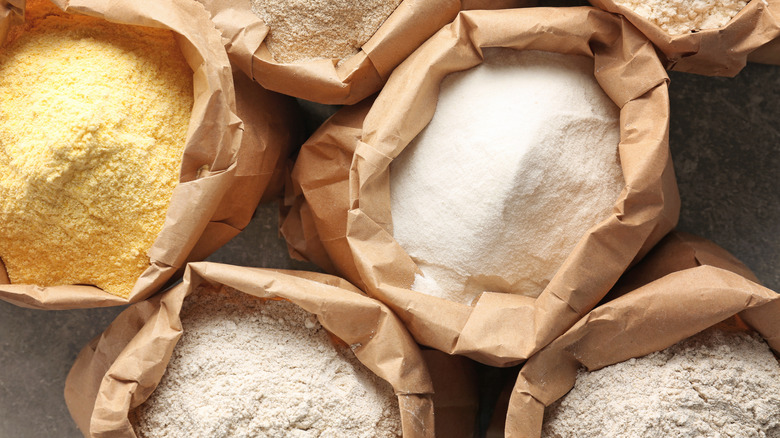Pastry Flour Vs. Cake Flour: What's The Difference?
If you've been cooking and baking under the assumption that all-purpose flour is the only option out there, you might want to take a seat. Surprise: there are tons of types you can use in place of common all-purpose, from wheat-and-grain-free flours to flours designed for specialized baking projects.
Traditionally, flour is made up of finely-milled wheat or grains (via Food Network). Now, of course there are your gluten-free variations, but even the wheat flours can be divided up based on one key factor — protein content. During the kneading or mixing process, the protein in flour helps form gluten, which in turn gives baked goods their structure. The higher the protein content, the more gluten and the more "structured" your final product will be.
Generally, the protein content in all-purpose flour comes in at around 11%, according to Epicurious. But for goods like tender cakes and pies, bakers should opt for a flour with less protein, like pastry or cake flours. Both have low protein contents, but cake flour has the lowest, somewhere between 5% and 8%. Pastry flour is more of a happy medium, with a protein content somewhere between cake and all-purpose flour, per Food Network. If you're having trouble deciding whether to use cake or pastry flour for your next baking project, here are some pointers.
Which flour is softer?
Although both flours are considered to be "soft" flours (compared to "hard" flours, which are generally used for baking bread), cake flour is going to be softer than pastry flour for a few reasons. The first has to do with the protein content. Though the difference in percentage between two flours isn't huge, it's enough for foods made with cake flour to be the softest, most tender treats of all, which is why it's excellent for delicate desserts like angel food cake (via Epicurious).
The process of making cake flour also primes it to be one of the softest flours you can get your hands on. According to Bob's Red Mill, cake flour is milled to an extremely fine consistency, but it's also almost always bleached. The bleaching process chemically refines flour, Healthline notes, which further weakens the protein and creates a "whiter color, finer grain, and softer texture." So, while pastry flour is already a soft, fine flour, cake flour is even softer and finer, especially if it's bleached.
Which flour is less carb-heavy?
Let's compare the two in terms of carbs. Carbohydrates are a macronutrient and are part of a healthy balanced diet; they're most often found in foods like bread, pasta, potatoes, and beans (via Harvard School of Public Health). Because carb-heavy foods like breads and pastas are often made with varieties of wheat flour, we can trace the carb content back to the product used.
The nutrition labels for General Mills' cake and pastry flours actually yield almost identical results. You will find 76 grams of carbohydrates per 100 grams of Gold Medal Golden Shield Enriched and Unbleached Cookie & Pastry Flour. Per 100 grams of Gold Medal Purasnow Hi-Ratio Bleached and Enriched Cake Flour, you'll get 77 grams of carbohydrates. A close call, but the comparison between the two gives cake flour the edge by a single gram.
Keep in mind that wheat flours in general are going to have more carbohydrates than their wheat-free counterparts. If you're looking for carb-conscious flours, Healthline suggests opting for a substitute like almond flour.
Which flour do you use to bake cakes?
As the name suggests, cake flour is often used to bake cakes. Remember, cake flour is extremely fine-ground and soft, which gives way to a very tender crumb, but also an increased ability to soak up water. The extra water absorption helps eliminate any clumping in the batter, thus allowing for a taller, moister cake than you'd get with all-purpose or even pastry flour (via Bob's Red Mill).
Because of the fine, pillowy-soft texture and low protein content of cake flour, you can expect cakes that are nothing less than delicate. The flour will give it some structure, but just enough so that it stays together (via Masterclass). The end result is a fluffy, light-as-air sponge that will make you question why cake flour was never in your pantry before. Aside from angel food cake, Epicurious lists pound cake and layer cake as some other popular desserts that incorporate cake flour in their recipes.
Which flour do you use to make pies?
For flakey yet tender pie crusts, pastry flour is your flour of choice. With a protein content slightly higher than cake flour but still less than all-purpose, pastry flour is ideal for, well, pastries. Keep in mind that it's still a very soft flour, but just not quite as soft as cake flour. So, your baked goods will have just a little more structure to them, but not much.
Tarts and croissants also benefit from pastry flour, but pies especially do. Pastry flour, as it's finely-milled, allows a crust to be flaky but not overly crumbly and coarse, My Recipes points out. Instead, the crust is fine, and has just enough protein and gluten to keep your perfected pie lattice together. Pastry flour can also be used to concoct cookies, cinnamon rolls, biscuits, and even pancakes, per Bob's Red Mill, so it's a good flour to have on hand.
Can you substitute pastry flour for cake flour?
The answer is yes, but there are some key considerations you'll need to keep in mind. Cake flour is best used in some of the aforementioned cakes that require a light, airy texture. If you don't have cake flour around, you can substitute pastry flour, but expect the final product to be slightly more dense. Still, it's the closest match when compared to all-purpose, self-rising and whole-wheat flours.
Because cake flour has a lower protein content compared to other flours, you can actually create a substitute for pastry flour by combining it with a higher protein variety. To do this at home, you'll simply need to mix together a single cup of cake flour and 2 cups of all-purpose flour (via The Kitchn). Sift them together a couple of times to make sure they're well-blended, and you'll get a close match to pastry flour in terms of protein content.
